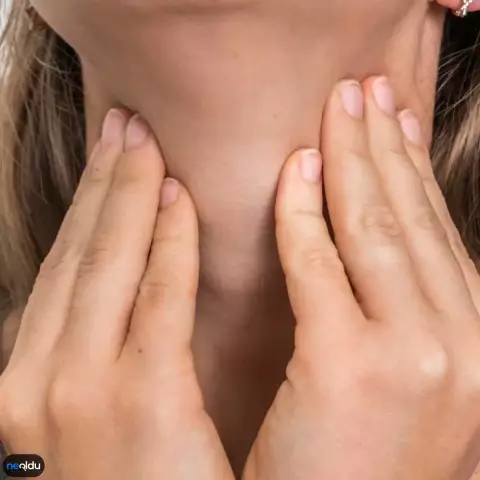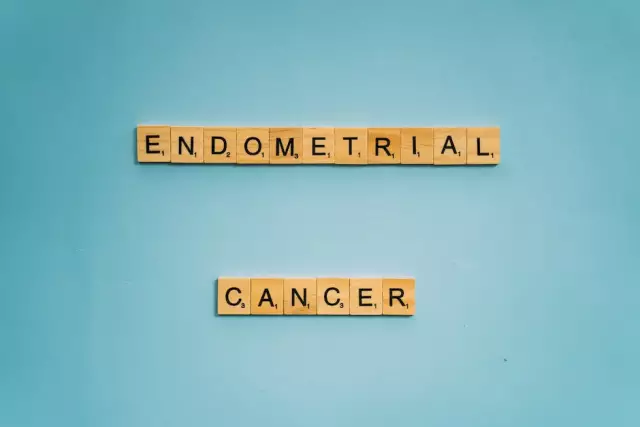- Author Rachel Wainwright [email protected].
- Public 2023-12-15 07:39.
- Last modified 2025-11-02 20:14.
Hyperplasia of the thyroid gland
The content of the article:
- Causes
- Kinds
- Signs
- Features of the course of thyroid hyperplasia in children
- Diagnostics
- Treatment
- Prevention
- Complications and consequences
Hyperplasia of the thyroid gland is a process of proliferation of glandular tissue and an enlargement of the thyroid gland with the gradual development of endocrinopathy. The early stages of the proliferative process are usually asymptomatic, with a significant increase in the volume of the gland and pronounced disorders of the secretion of thyroid hormones, a diffuse or nodular goiter is diagnosed.

Source: thyroid-consultor.ru
Causes
Hyperplasia of the thyroid gland is a manifestation of a number of chronic diseases, pathological conditions and nutritional disorders:
- chronic foci of infection;
- congenital endocrine pathologies;
- iodine deficiency;
- genetic abnormalities;
- autoimmune and immunodeficiency states;
- hormone-producing tumors.
Often, the proliferative process is a manifestation of prolonged suppression of the functions of the thyroid gland with frequent contact with toxic substances, smoking and alcohol abuse, exposure to adverse environmental factors, radiation and prolonged stress, frequent use of products with synthetic coloring additives, as well as with the systematic intake of iodine-containing drugs - beta -adrenergic antagonists, neuroleptics, antidepressants, hormonal, anticonvulsant and antiemetic drugs. Occasionally, constitutionally determined idiopathic hyperplasia of the thyroid gland occurs, the exact reasons for the development of which cannot be established.
In women, hyperplasia of the thyroid gland occurs 2-4 times more often than in men. The risk group includes mainly postmenopausal women, pregnant and lactating women.
Kinds
In endocrinological practice, three types of thyroid hyperplasia are distinguished:
diffuse - tissue proliferation and an increase in organ size occurs evenly
- nodal - characterized by the formation of one or more seals;
- mixed - a uniform increase in the thyroid gland is accompanied by the formation of nodes.
The most common are mixed and nodular hyperplasia of the thyroid gland, they are found in 40-50% of the population. Up to 90% of all benign formations occur in nodular colloid proliferating goiter, in 5-8% of cases benign adenomas are diagnosed; together with the nodes, cystic changes in the glandular tissue are often revealed. Sometimes the type of nodes acquire inflammatory infiltrates, which are formed in autoimmune and subacute thyroiditis. In elderly people, nodular goiter is considered as a variant of age-related degeneration of glandular tissue, and in women, this pathology is often accompanied by uterine myoma.

Source: endokrinnayasistema.ru
As a rule, diffuse thyroid hyperplasia develops against the background of inflammatory processes, diffuse-toxic and endemic goiter, as well as with hormone-producing neoplasms.

Source: shhitovidka.ru
Signs
The clinical picture of thyroid hyperplasia depends on the etiology, stage of the process and the presence of concomitant diseases. The physical diagnosis of proliferative changes is based on the classification of stages of hyperplasia according to O. Nikolaev:
- 0 - proliferative processes are limited to the cellular level;
- I - when swallowing, the protruding isthmus of the thyroid gland is felt;
- II - an increase in the organ is noticeable when swallowing and is easily determined by palpation;
- III - an enlarged thyroid gland expands the contour of the neck;
- IV - pronounced goiter and noticeable deformity of the neck;
- V - growing goiter compresses the esophagus and trachea, making it difficult to breathe and swallow. Patients complain of a lump in the throat, cough and soreness in the front of the neck.
When the nerves of the vocal cords are compressed in patients, coarseness and hoarseness of the voice is noted; prolonged compression of the blood vessels causes redness and swelling of the neck. Compression of the vertebral and carotid arteries is accompanied by signs of cerebrovascular accident, headache, dizziness, apathy, attacks of nausea and vomiting, not associated with food intake.
For the nodular form of hyperplasia, abnormal indicators of the content of thyroid-stimulating hormone and iodothyronines in the blood serum are characteristic. Hyperthyroidism can be suspected with the simultaneous appearance of a number of indirect signs:
rapid heartbeat (tachycardia)
- increased blood pressure;
- irritability and aggressiveness;
- redness of the eyes and their shine;
- exophthalmos;
- periorbital edema;
- photophobia;
- diarrhea and abdominal pain;
- shaking hands (tremors);
- insomnia;
- rapid emaciation or sharp fluctuations in body weight.
The following symptoms may indicate hypothyroidism:
- weakness, drowsiness and increased fatigue;
- loss of appetite;
- lowering blood pressure;
- dilated pupils;
- slowing heart rate (bradycardia);
- sweating;
- fast weight gain;
- dry skin;
- constipation;
- emotional lability;
- neurotic and psychotic states - depression, anxiety, panic attacks;
- decreased libido;
- violations of the menstrual cycle and reproductive function in women.
Features of the course of thyroid hyperplasia in children
An enlarged thyroid gland in children can be a sign of congenital hypothyroidism, which leads to a delay in mental and physical development. With timely started hormone replacement therapy, the disability of the child can be avoided.
Changes in the level of thyroid-stimulating hormone and thyroid hormones appear no earlier than on the 30th day of life. Earlier, parents may be alerted by non-specific manifestations of congenital hypothyroidism:
- birth weight over 3.5 kg;
- lingering jaundice;
- dryness and flaking of the skin;
- nervousness;
- cyanosis of the nasolabial triangle;
- a tendency to constipation;
- excessive excitability.
The appearance of hypothyroidism in a pregnant woman increases the risk of hypothyroidism in a child, therefore, during the period of gestation, one should not abandon dispensary observation.
Acquired hypothyroidism in children develops with iodine deficiency and against the background of inflammatory diseases of internal organs.
Diagnostics
Physical examination is not enough to recognize the initial stage of thyroid hyperplasia, especially in the nodular form. Palpation reveals only large nodes ranging in size from 5-10 mm; smaller ones are found only through instrumental techniques - MRI, CT and ultrasound of the thyroid gland. Normally, the volume of an organ in men is up to 25 cm 3; in women - up to 18 cm 3. To confirm the benign nature of neoplasms, scintigraphy and tumor biopsy are additionally prescribed.
If hyperplasia is detected, it is required to take a blood test for pituitary thyroid stimulating hormone (TSH), which stimulates the production of thyroid hormones. Normal serum TSH levels in adult patients range between 0.3 and 4.2 μIU / ml. Increased values indicate hypothyroidism; reduced - about hyperthyroidism.
In children, the activity of the pituitary gland is higher than in adults. The maximum concentration of TSH in blood plasma is observed in infants under the age of 4 months, reaching 0.7-11 μIU / ml, after which the indicators begin to decrease and are:
- from 4 months to 1 year - 0.7-8.35 μIU / ml;
- from 1 year to 7 years - 0.7-6 μIU / ml;
- 7-12 years old - 0.6-4.8 μIU / ml;
- 12-20 years old - 0.5-4.3 μIU / ml.
High TSH levels can also be observed in healthy people with intense physical exertion, a low-calorie diet and strong emotional experiences, as well as in the last trimester of pregnancy. In addition, the reference values may vary depending on the reagents used.
To clarify the diagnosis, the determination of the level of thyroid hormones - thyroxine (T4) and triiodothyronine (T3) is shown. The concentration of T3 in blood plasma in healthy adults ranges from 66 to 181 nmol / l; in children and people under 20 years old - 73-216 nmol / l. The reference values for T4 are 1.2-3.1 nmol / L in adult patients, and in children they change with age:
- up to 1 year - 1.23-4.07 nmol / l;
- from 1 to 7 years - 1.42-3.80 nmol / l;
- 7-12 years old - 1.43-3.55 nmol / l;
- 12-20 years old - 1.40-3.34 nmol / l.
With concomitant diseases, you may need to consult other specialists - a cardiologist, gynecologist, gastroenterologist, neuropathologist.
Treatment
Asymptomatic grade 0 - II thyroid hyperplasia does not need treatment, but the patient should be monitored by an endocrinologist. It is recommended to undergo control ultrasound and be tested for TSH and thyroid-stimulating hormones 2-3 times a year.
In the early stages, a course of hormonal and iodine-containing drugs is prescribed. In most cases, a reduction in goiter is achieved within 3-6 months. With the low efficiency of conservative methods, the issue of surgical intervention is considered. The amount of resection depends on the severity of the pathology. Small nodes and cysts are removed by means of enucleation - destruction of the pathological focus inside the capsule; there is also evidence of successful application of minimally invasive surgery techniques.
In advanced cases, they resort to complete or partial removal of the thyroid gland. Hemithyroidectomy - removal of the affected organ lobe with an isthmus - can be performed at the request of a patient experiencing discomfort from an unaesthetic goiter.
For thyroidectomy and subotatal resection of the thyroid gland, there must be serious grounds - the addition of an inflammatory process, compression syndrome, suspicion of oncopathology. After such operations, the patient needs lifelong hormone replacement therapy.
Prevention
Specific prevention is reduced to the intake of calcium iodide and other iodine preparations. Mass iodine prophylaxis is designed primarily for residents of regions with a frequent occurrence of endemic goiter. Individual iodine prophylaxis is indicated for persons at risk: pregnant and lactating women, children, workers in hazardous industries, persons with congenital endocrine pathologies and the elderly. It is also important to adhere to the basic principles of rational nutrition and, if possible, exclude semi-finished products and products of questionable quality from the diet. A healthy lifestyle plays an important role: a balanced daily routine, minimizing stress, giving up bad habits, avoiding excessive work and sports loads.
Complications and consequences
With a prolonged decompensated course of the proliferative process, the probability of goiter malignancy is not excluded; the degree of cancer risk is estimated at 5%. Of the acute complications, the most common are compression syndrome and rupture of blood vessels, as a result of which the goiter sharply increases in size and makes breathing very difficult. In the case of the addition of an inflammatory process, a toxic form of the disease develops. The long-term consequences of hyperplasia of the thyroid gland, aggravated by hypothyroidism or hyperthyroidism, include pathological reactions from the nervous, cardiovascular and reproductive systems, disorders of lipid-carbohydrate metabolism, male and female infertility, neuroses, psychotic and sexual disorders.
YouTube video related to the article:

Anna Kozlova Medical journalist About the author
Education: Rostov State Medical University, specialty "General Medicine".
The information is generalized and provided for informational purposes only. At the first sign of illness, see your doctor. Self-medication is hazardous to health!






